
Personal thoughts during a visit in the |
June, 17th, 1974. This is a historical date for all toy-lovers. On this day Sweden's first Toy Museum was opened by His Majesty King Carl XVI Gustaf in Tidö Castle.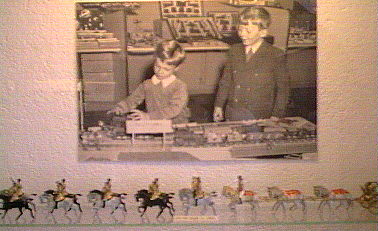 |
|
Of course you expect some obligation together with such patronage, this is why you can see quite a lot of little Carl Gustaf's own toys in the museum today. On this picture he is busy conducting an electric train-set, and the riding soldiers in the front have been a personal gift to him from England. But you are mistaken if you suppose that you can see toys from rich families only. An important part of the exhibition are glued toys designed on paper, published by a weekly family-magazine throughout decades. There are |
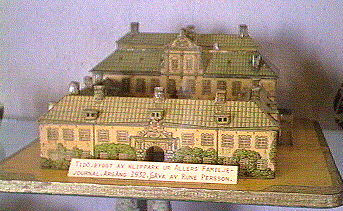 paper cars, dolls, new inventions and famous buildings. Even Tidö Castle could be reconstructed, as you can see to the right. And the magazine cost at that time only 25 öre which most people could afford - this can be learned in the museum as well.
paper cars, dolls, new inventions and famous buildings. Even Tidö Castle could be reconstructed, as you can see to the right. And the magazine cost at that time only 25 öre which most people could afford - this can be learned in the museum as well.
It is rather entertaining to spend some time at the entrance of the building, listening to the discussions. Of course, many of the visitors are families with children, the latter standing there with shining eyes, full of expectation, while their fathers feel less comfortable. |
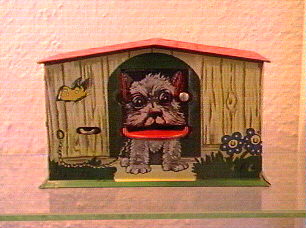 expectations neither were at a very high level, when I entered. But all it took was ten minutes of time, until I found "Lumpi", my very first savings-box, which I fed with pennies back in the fifties. To see it again, suddenly remembering the feeling, what it was like to push that little iron lever to the left, which made the dog's tongue disappear together with the coin, well, that made my legs feel shaky for a moment.
expectations neither were at a very high level, when I entered. But all it took was ten minutes of time, until I found "Lumpi", my very first savings-box, which I fed with pennies back in the fifties. To see it again, suddenly remembering the feeling, what it was like to push that little iron lever to the left, which made the dog's tongue disappear together with the coin, well, that made my legs feel shaky for a moment.My next impression was the international point of view. Many of the toys are well-used, a sure sign of their former owners' affection. And the owners were spread all over the world, there are toys from Germany, from Japan, from the United States and Russia. But whereever |
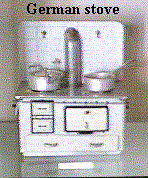
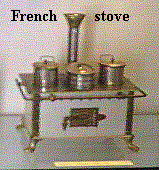 they were living, they played with the same kind of toys, unaware of nationality, racism or any other barriers we rise between men, when we well have grown up.
they were living, they played with the same kind of toys, unaware of nationality, racism or any other barriers we rise between men, when we well have grown up. While two girls were extending their fantasies, playing with one of those stoves, their fathers tried to kill each other at the same time. It is a pity, that men don't visit a toy museum more often..... It seems as if man throughout the ages has tried to imitate reality when making toys, no matter if it happens to be a |
 model of a tram or a doll's house with all those small refinements a contemporary home would have shown. Impressive are not at least the china service-sets with all their details. Those gadgets on the picture could as well represent a service you could find in any kitchen, if you don't have any reference to decide their size.
model of a tram or a doll's house with all those small refinements a contemporary home would have shown. Impressive are not at least the china service-sets with all their details. Those gadgets on the picture could as well represent a service you could find in any kitchen, if you don't have any reference to decide their size. |
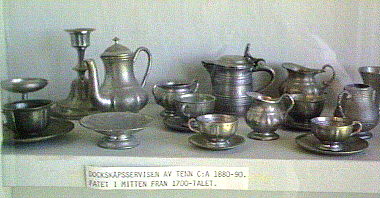 This is why the impact on your mind becomes much more intensive, being able to really see those miniatures, not much more than an inch high. The pewter dishes could - in grown-up size - be the pride of any diningtable, couldn't they? But when I found the silver coffee-cups, it became too much, my social consciousness responded. Was this really necessary, to lavish one's resources on such an expensive toy, or could they have been spent in a more humanitarian way? Yes, it is cute, and yes, every parent likes his children and wants only the best for them, but doesn't this mean putting wrong ideas into their minds, too?
This is why the impact on your mind becomes much more intensive, being able to really see those miniatures, not much more than an inch high. The pewter dishes could - in grown-up size - be the pride of any diningtable, couldn't they? But when I found the silver coffee-cups, it became too much, my social consciousness responded. Was this really necessary, to lavish one's resources on such an expensive toy, or could they have been spent in a more humanitarian way? Yes, it is cute, and yes, every parent likes his children and wants only the best for them, but doesn't this mean putting wrong ideas into their minds, too? |
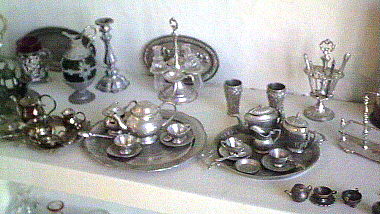 This resembles very much Dagobert Duck in his vault..... At the same time I cannot close my mind to the images, which Swedish authors like Vilhelm Moberg or Ivar-Lo Johansson have painted, describing the same society but from a very different angle. Too look at silver toys gives an almost scornful feeling with regard to the contemporary working-class people.
This resembles very much Dagobert Duck in his vault..... At the same time I cannot close my mind to the images, which Swedish authors like Vilhelm Moberg or Ivar-Lo Johansson have painted, describing the same society but from a very different angle. Too look at silver toys gives an almost scornful feeling with regard to the contemporary working-class people. The advantage of being in a toy museum is that gloomy thoughts don't have a chance to consist, blown away by the assembled joy to be found there. |
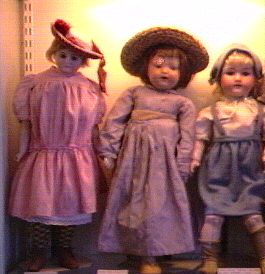 The manifolded impressions make you thinking new thoughts right away, you get caught by the timeless view, which some of the toys provide. The dolls are a typical example of this. And there are many dolls from many different ages and areas! The thought that little girls have been playing with dolls at any time, overcomes somehow the difference between generations. I feel suddenly closer to my ancestors, who really were not so different, at least as children they were looking for the same pleasures and therefore they ought to have had the same feeling as we have. Unmentioned the fact, that their dolls were plainer, looking at material as well as design, but that does not change the symbolism.
The manifolded impressions make you thinking new thoughts right away, you get caught by the timeless view, which some of the toys provide. The dolls are a typical example of this. And there are many dolls from many different ages and areas! The thought that little girls have been playing with dolls at any time, overcomes somehow the difference between generations. I feel suddenly closer to my ancestors, who really were not so different, at least as children they were looking for the same pleasures and therefore they ought to have had the same feeling as we have. Unmentioned the fact, that their dolls were plainer, looking at material as well as design, but that does not change the symbolism. Or look at the toy bricks. The same thing goes for them. There have always been building bricks, and if you painted them, so they could be laid as a puzzle as well, |
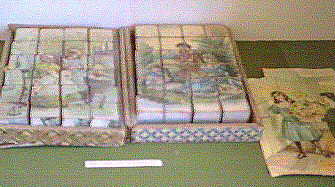 it was even more stimulating for the children.
it was even more stimulating for the children.
The next thought hitting me is diametrically opposed. This time it is not the timelessness I feel, but instead the development of cultural history. A great impression was the movie projector, which was run with an oil lamp as illumination. Naturally the celluloidtape with the image-frames on it is already cracked and crumpled, but you get the idea of it. And I feel grateful as well as amazed. Amazed because of the realization, that it really was possible to run a "movie" in such a flickering light, and grateful because of the new experience, showing which simple technique was used a hundred years ago - but if it had not been tried, we would not have our everyday objects as television, phones or computers. And I wonder if we today are trying to use the same simple techniques, when communicating on the Internet. What will communication be like a hundred years from today? |
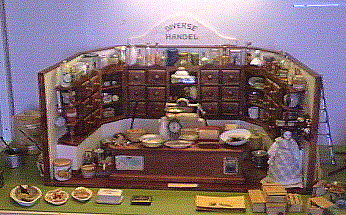 However, this museum gives a great insight into cultural history. Take a look at the store on this picture. Its total hight may be 12 or 15 inches! It is fascinating to see the precision of the details as well as seeing it as a source of knowledge. How valuable this toy must be for all of those who are only used to supermarkets because they are too young to have seen such a store in reality!
However, this museum gives a great insight into cultural history. Take a look at the store on this picture. Its total hight may be 12 or 15 inches! It is fascinating to see the precision of the details as well as seeing it as a source of knowledge. How valuable this toy must be for all of those who are only used to supermarkets because they are too young to have seen such a store in reality!There are, as I said before, many, many toys to look at - and it is really impossible to mention everything there is to see or all of the emotions you get during your visit. Here I have tried to mirror some of the thoughts which I had in the museum, those I feel were most important. The visit cost me about as much time and money as it would to rent and see a video, the memories outclass any video by far....
|
Copyright Bernhard Kauntz, Västerås, August 1996
 or to the
or to the  of
of 
last update: 23.8.1996 by webmaster@werbeka.com